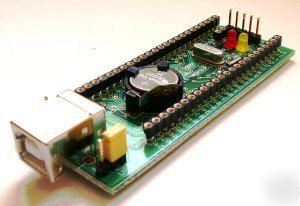Iowa Industrial Moderated Newsgroup For Surplus Equipment > Industrial Machine Repair
> Components
> Used
> Arm 32 bit microcontroller development board
Arm 32 bit microcontroller development board
Powerful easy to use 32 Bit Microcontroller.
This board is based on the powerful ARM LPC2132 microcontroller. It is ready to go as soon as the USB cable is plugged in and the drivers* loaded. There is no need for complex tool chains, compilers or assemblers. It takes it power from the USB interface and there is on board regulators to protect the supply. The firmware contains an operating system within the Flash, this can be easily upgraded (or replaced) via the USB interface. The firmware allows user programs written in RAM to be saved to Flash and optionally be run on reset.
*USB drivers provided for Widows, MAC and Linux
1. The processor board (full details can be found at www.pin1.org )
The BV511 processor board as shown
CD-ROM containing firmware drivers and datasheets
* CPU – Philips LPC2132 running at 60MHz
* Real Time Clock with Battery back up
* Power supply - from USB or external, fully regulated
* Power Output - 5V and 3V3 regulated
* Programming - via USB using built in operating system or download firmware using Phillips Flash utility
* IASI (Intelligent Asynchronous Serial Interface), 5 pin connector to second UART
* 3V3 logic with compatible 5V input
* Interfaces - SPI, UART, I2C, AtoD, Timers
* Current consumption approximately 50mA
This device can serve as a platform for learning about 32Bit microcontrollers but because it is so small it can also form the hub of a controller project. The operating system allows the paced build up of functionality cumulating in a complete system. Because of the USB interface subsequent changes to the firmware can be done 'in-system'
Robotics, MP3 players, Video processing, Audio processing, Data logging, Environmental control, Process control, image sensing, Games
The output ports use high quality sockets making the board very easy to use with a breadboard system
* No software tools required, program anywhere, no special applications to load onto the PC
* USB virtual com port interface, 2.0, version 1.1 compatible
* Students do not need to be tied to the computer labs software tools
* Powerful 32bit microcontroller, Philips LPC2132
* Real time clock with battery back up
* High level programs can be saved to Flash, using SAVE command
* Stand alone, start up programs can be created
* 40+ I/O lines with the usual AtoD, DtoA, timers, I2C etc.
* Software resources included for MMC/SD memory cards, Graphic LCD displays etc.
* 100 page foundation book full of project examples.
Nothing else is needed, the board is ready to go as soon as the USB drivers have been loaded on the the PC. A terminal emulator* is provided but any will do.
*The terminal emulator provided is for Windows only
The firmware is a 32bit Forth written in ARM assembler, from scratch, for this processor.
Can I use it for other languages
Yes the Flash can be programmed via the USB interface using the Phillips Flash Utility. The only language supported is Forth but there are plenty of free tools around if you have the time and patience to learn them.
A program is made up of individual subroutines called words, these can be tested individually and brought together to form a complete application. The words can either be typed directly into the device or into a program or text editor and downloaded using text transfer. The words are compiled into RAM and can be run from there. At any time they can be transferred to Flash simply by issuing the SAVE command.
Yes once an application has been created the SAVE command can be followed by the word to be run at start up, something like SAVE GO.
What happens if my program corrupts the firmware?
The firmware is provided on CD-ROM as a hex file, simply erase the Flash and reload using the Flash Utility. This will give a clean brand new system.
Is the source code available for the firmware?
No but there is plenty of application code provided on the CD-ROM to give ideas and examples of how to use the board.
This is initially fixed at 115200 but can be changed once initial communication has been established.
What power supply is required?
The BV511 is self powered through the USB interface, this passes through two regulators a 5V and a 3V3. The first 5V regulator offers short circuit protection to the USB interface (as the board is ideal for experimentation). There is a jumper to deselect the USB power and a pin to supply power directly to the board for stand alone applications. Up to 10V DC is acceptable but this of course depends on the current and eventual end use application.

